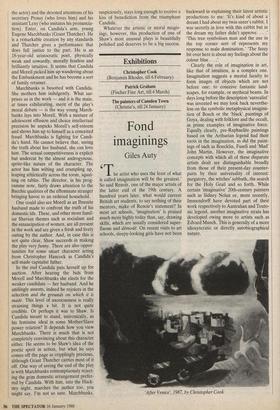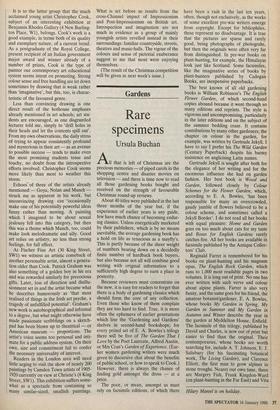Exhibitions
Christopher Cook (Benjamin Rhodes, till 6 February) Patrick Graham (Fischer Fine Art, till 4 March)
Fond imaginings
Giles Auty
The artist who uses the least of what is called imagination will be the greatest.' So said Renoir, one of the major artists of the latter end of the 19th century. A hundred years later, what would current British art students, to say nothing of their mentors, make of Renoir's statement? In most art schools, 'imagination' is praised much more highly today than, say, drawing skllis, which are usually considered super- fluous and demode. On recent visits to art schools, sleepy-looking girls have not been backward in explaining their latest artistic productions to me: 'It's kind of about a dream I had about my twin sister's rabbit. I was secretly in love with this rabbit but in the dream my father didn't approve. . . `This tree symbolises man and the axe in the top corner sort of represents my response to male domination.' The fuzzy bit over here is about my feelings about the colour blue. .
Clearly the role of imagination in art, like that of intuition, is a complex one. Imagination suggests a mental faculty to form images of objects which are not before one: to conceive fantastic land- scapes, for example, or mythical beasts. In days long before the description 'surrealist' was invented we may look back neverthe- less on the symbolic metaphysical imagina- tion of Bosch or the 'black' paintings of Goya, dealing with folklore and the occult, as prime examples of imaginative force. Equally clearly, pre-Raphaelite paintings based on the Arthurian legend had their roots in the imagination, as did the paint- ings of such as Boecklin, Fuseli and 'Mad' John Martin. However, the imaginative concepts with which all of these disparate artists dealt are distinguishable broadly from those of their present-day counter- parts by their universality of interest: purgatory, the witches' sabbath, the search for the Holy Grail and so forth. While certain 'imaginative' 20th-century painters such as Sidney Nolan or, more recently, Immendorff have devoted part of their work respectively to Australian and Teuto- nic legend, another imaginative strain has developed owing more to artists such as Edvard Munch. This is generally of a more idiosyncratic or directly autobiographical nature.
'After Venice', 1987, by Christopher Cook It is to the latter group that the much acclaimed young artist Christopher Cook, subject of an interesting exhibition at Benjamin Rhodes Gallery (4 New Burling- ton Place, W1), belongs. Cook's work is a good example, in terms both of its quality and exemplary nature, of a current trend. As a postgraduate of the Royal College, present recipient of an Italian government major award and winner already of a number of prizes, Cook is the type of painter our contemporary art educational system seems intent on promoting. Strong colour sense and free handling are let down sometimes by drawing that is weak rather than 'imaginative', but this, too, is charac- teristic of the favoured genre.
Less than convincing drawing is one direct result of the hothouse emphases already mentioned in art schools; art stu- dents are encouraged, as one disgruntled lecturer told me, simply to 'drill holes in their heads and let the contents spill out'. From my own observations, the daily stress of trying to appear consistently profound and mysterious in their art — as an avenue to possible success — tends to make even the most promising students tense and touchy, no doubt from the introspective efforts involved. Christopher Cook seems more likely than most to weather this storm.
Echoes- of three of the artists already mentioned — Goya, Nolan and Munch — struck me as apparent in his work, but unconvincing drawing can 'occasionally make one of his potentially powerful ideas funny rather than moving. A painting which I imagined to be about sexual jealousy fell into this category, but then this was a theme which Munch, too, could make look melodramatic and silly. Good art relies on artistry, no less than strong feelings, for full effect.
At Fischer Fine Art (30 King Street, SW1) we witness an artistic comeback of another personable artist, almost a genera- tion older than Cook. Patrick Graham was also something of a golden boy in his era and was rewarded similarly for precocious gifts. Later, loss of direction and disillu- sionment set in and the artist became what he describes humorously as 'that most realised of things in the Irish art psyche, a tragedy of unfulfilled potential'. Graham's new work is autobiographical and informal to a degree, but what might otherwise have made passionate scribblings on a sketch- pad has been blown up to theatrical — or American museum — proportions. The artist's voice seems too personal and inti- mate for a public address system. On their own, size and commitment fail to confer the necessary universality of interest. Readers in the London area will need little urging to visit the show of nearly 200 Paintings by Camden Town artists of 1905- 1920 currently on view at Christie's (8 King Street, SW1). This exhibition suffers some- what as a spectacle from containing so Many similar-sized, smallish paintings. What is set before us results from the cross-Channel impact of Impressionism and Post-Impressionism on British art. Introspection and imagination are not much in evidence as a group of mainly youngish artists revelled instead in their surroundings: familiar countryside, streets, theatres and music-halls. The vigour of the colours and sense of pictorial exuberance suggest to me that most were enjoying themselves.
(The result of the Christmas competition will be given in next week's issue.)



















































 Previous page
Previous page